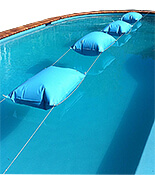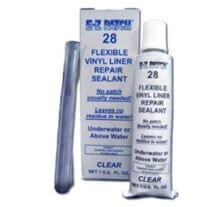Protecting Pool Liners from Ice Damage

Ice and vinyl liners normally play nice together, but there are a few situations where large and heavy ice sheets can damage a pool liner.
Most pools in the northern half of the US will freeze solid across the surface, during winter, from just 1/4″ to 6-8″ thick in colder regions.
Protect your pool liner from ice damage, with these simple tips!
Winter Pool Liner Ice Protection

Air Pillows: The first problem with an ice sheet forming across the pool, is it’s 10% bigger than the pool. This puts enormous pressure on the walls and on a vinyl liner. Air Pillows break up the ice sheet, and relieve the outward pressure, because the water won’t freeze beneath an air pillow. Use under aboveground or inground pool covers.

Small pools can use one Air Pillow, but larger pools should use 2 or 3. Inflate them with a shop vac, about 2/3 full, and position in the middle of the pool. A rope or twine can be run through the air pillow grommets, to hold them in place in the center of the pool.

Pull the cover tightly to push the pillow into the water surface slightly. Cover clips or wall bags are useful on above ground pools, to keep the cover taught. In ground pools can keep a small amount of water on the cover, under 1″, to help hold the cover in place over the air pillows.
Winter Leaks: The second big problem or fear with winter ice sheets is that if the pool begins to leak water, below the ice sheet, it has no support. When the ice sheet thaws very slightly, it will fall and possibly sharp edges could rip the pool liner.

Check your pool during the winter for leaks by walking around the outside of the pool, looking for spongy spots, and pulling the pool cover back, and checking the water level in the pool. If you do find that your frozen pool has a slow leak, add water to maintain the level until warmer weather will allow using a pool vinyl liner repair kit.

My most often used vinyl repair kit however, is not a kit at all, just my tube of flexible vinyl liner repair sealant like the EZ-Patch 28. Squeezes out like toothpaste, just smooth it with your fingers. Great for small holes and tears and for sealing around wall return and skimmer faceplates. And, much easier for patching vinyl liners in winter! See also: Anderson’s Flexible Sealer.
Pond Heaters: I’ve known 1 or 2 pool owners use a pond heater inside their pool to stop a continuous ice sheet from forming. These are floating electric heaters used for koi ponds or farm animal water troughs. They plug into an outlet and sense the water temperature, coming on when needed.

As a solution to the problem, pond heaters do stop an ice sheet from forming, unless the power is turned off. They are affordable, at around $50, but they consume lots of watts, and can be expensive to operate. They won’t keep your pool from freezing, but will keep a small area liquid, just a small amount larger than the pond heater itself.
What Not to Do with Ice
We’ve covered 3 things you can do to protect your pool liner from winter ice. Here’s several things Not to Do with ice in your pool.
- Don’t chip or break up the ice sheet.
- Don’t float logs or tires to break up the ice sheet.
- Don’t use a garden hose to try to melt the ice sheet.
- Do Not (!) walk or skate on the ice sheet.
Original source: https://blog.intheswim.com/protecting-pool-liners-from-ice-damage/

